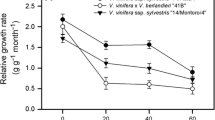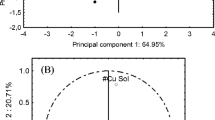Abstract
High soil copper (Cu) concentrations in vineyards can cause phytotoxicity to grapevine rootstocks. In order to mitigate toxicity, the use of grapevine rootstock genetic variation and the application of amendments are possible strategies. The aim of this study is to assess the tolerance of grapevine rootstocks to Cu excess and whether phosphorus (P) and calcium (Ca) can reduce phytotoxicity caused by Cu. Grapevine rootstock seedlings were produced from selected stakes: Paulsen 1103 (Vitis berlandieri × Vitis rupestris); SO4 (Vitis berlandieri × Vitis riparia); IAC 572 ((Vitis Riparia × Vitis rupestris) × Vitis caribaea); and Isabel (Vitis labrusca). Seedlings were grown in nutrition solution added with the following treatments: 0.3 µM Cu (control); 60 µM Cu; 60 µM Cu and 62 mg L−1 P; 60 µM Cu and 400 mg L−1 Ca. High Cu concentration caused phytotoxicity in all rootstocks, impairing their growth and decreasing nutrient concentration and photosynthetic activity. P and Ca addition had positive effect on the photosynthetic activity of all rootstocks, although it was not enough to revert growth to levels comparable with controls. Overall, based on the results, the application of P and Ca was not efficient in mitigating Cu phytotoxicity in grapevine plants grown in solution. Isabel was the most sensitive rootstock to Cu phytotoxicity, whereas Paulsen 1103 and SO4 presented more tolerance and can be used, together with other management strategies, in contaminated vineyard areas. Therefore, careful genotype rootstock selection for use in high Cu soils is important, while Ca and P are not efficient mitigators of Cu toxicity.





Similar content being viewed by others
Data availability
The datasets used and/or analyzed during the current study are available from the corresponding author on reasonable request.
References
Adrees M, Ali S, Rizwan M, Ibrahim M, Abbas F, Farid M, Zia-ur-rehman M, Irshad MK, Bharwana SA (2015) The effect of excess copper on growth and physiology of important food crops: a review. Environ Sci Pollut Res 22:8148–8162
Ambrosini VG, Rosa DJ, Prado JPC, Borghezan M, Melo GWB, Soares JJ, Comin CRFS, Simão DG, Brunetto G (2015) Plant physiology and biochemistry reduction of copper phytotoxicity by liming : a study of the root anatomy of young vines (vitis labrusca l.). Plant Physiol Biochem 96:270–280
Ambrosini VG, Rosa DJ, Bastos de Melo GW, Zalamena J, Cella C, Simão DG, Souza da Silva L, Pessoa dos Santos H, Toselli M, Tiecher TL, Brunetto G (2018) High copper content in vineyard soils promotes modifications in photosynthetic parameters and morphological changes in the root system of ‘red niagara’ plantlets. Plant Physiol Biochem 128:89–98
Baldi E, Miotto A, Ceretta CA, Quartieri M, Sorrenti G, Brunetto G, Toselli M (2018a) Soil-applied phosphorous is an effective tool to mitigate the toxicity of copper excess on grapevine grown in rhizobox. Sci Hortic 227:102–111
Baldi E, Miotto A, Ceretta CA, Brunetto G, Muzzi E, Sorrenti G, Quartieri M, Toselli M (2018b) Soil application of p can mitigate the copper toxicity in grapevine: physiological implications. Sci Hortic 238:400–407
Baldi E, Miotto A, Toselli M, Ceretta CA, Brunetto G (2018c) Increasing phosphorus concentration in soil as a possible strategy to overcome cu excess toxicity symptoms. Acta Hort 1228:421–426
Brunetto G, Rosa DJ, Ambrosini VG, Heinzen J, Ferreira PAA, Ceretta CA, Soares CRFS, Melo GWB, Soriani HH, Nicoloso FT, Farias JG, de Conti L, Silva LOS, Santana N, Couto RR, Jacques RJS, Tiecher TL (2019) Use of phosphorus fertilization and mycorrhization as strategies for reducing copper toxicity in young grapevines. Scientia Horticulturae 248:176–183
Cambrollé J, García JL, Figueroa ME, Cantos M (2015) Evaluating wild grapevine tolerance to copper toxicity. Chemosphere 120:171–178
Chen P, Lee Y, Chen B, Juang K (2013) Effects of calcium on rhizotoxicity and the accumulation and translocation of copper by grapevines. Plant Physiology Et Biochemistry 73:375–382
Christensen LP (2003) Rootstock selection. In. Wine grape varieties in california. Christensen, l.p. Et al. (eds.), pp. 12–15. University of california agricultural and natural resources publication 3419, Oakland, CA
De Conti L, Ceretta CA, Melo GWB, Tiecher TL, Silva LOS, Garlet LP, Mimmo T, Cesco S, Brunetto G (2019) Intercropping of young grapevines with native grasses for phytoremediation of cu-contaminated soils. Chemosphere 216:147–156
Embrapa - empresa brasileira de pesquisa agropecuária (2009) Manual de análises químicas de solos, plantas e fertilizantes. 2. Ed. Rev. Ampl. Embrapa informação tecnológica: brasília,. 627p
Ferreira DF (2008) Sisvar: um programa para análises e ensino de estatística. Revista Symposium 6:36–41
Ferreira PAA, Marchezan C, Ceretta CA, Tarouco CP, Lourenzi CR, Silva LS, Soriani HH, Nicoloso FT, Cesco S, Mimmo T, Brunetto G (2018) Soil amendment as a strategy for the growth of young vines when replanting vineyards in soils with high copper content. Plant Physiol Biochem 126:152–162
Guimarães PR, Ambrosini VG, Miotto A, Ceretta CA, Simão DG, Brunetto G (2016) Black oat (avena strigosa schreb.) Growth and root anatomical changes in sandy soil with different copper and phosphorus concentrations. Water Air Soil Pollut 227:192
Hiscox JD, Israelstam GF (1979) A method for the extraction of chlorophyll from leaf tissue without maceration. Can J Bot 57:1132–1334
Hippler FWR, Boaretto RM, Dovis VL, Quaggio JA, Azevedo RA, Mattos D Jr (2018) Oxidative stress induced by cu nutritional disorders in citrus depends on nitrogen and calcium availability. Sci Rep 8:1641
Hoagland DR, Arnon DT (1950) The water culture method for growth plants without soil. California agriculture experiment station, berkeley
Hochmal AK, Schulze S, Trompelt K, Hippler M (2015) Calcium-Dependent Regulation of Photosynthesis. Bba-Bioenergetics 1847:993–1003
Holland TC, Hart MM, Bogdanoff C, Bowen P (2018) Response of grapevine rootstocks to soil inocula from different sources. Am J Enol Vitic 69:94–100
Kabata-Pendias A (2011) Trace elements in soils and plants. [s.l.] Crc press, boca ratón, florida
Kováčik J, Dresler S, Babula P, Hladký J, Sowa I (2020) Calcium has protective impact on cadmium-induced toxicity in lichens. Plant Physiol Biochem 156:591–599
Lichtenthaler HK (1987) chlorophylls and carotenoids: pigments of photosynthetic biomembranes. Methods Enzymol 148:350–382
Marastoni L, Sandri M, Pii Y, Valentinuzzi F, Brunetto G, Cesco S, Mimmo T (2019a) Synergism and antagonisms between nutrients induced by copper toxicity in grapevine rootstocks: monocropping vs. Intercropping, chemosphere
Marastoni L, Sandri M, Pii Y, Valentinuzzi F, Cesco S, Mimmo T (2019b) Morphological root responses and molecular regulation of cation transporters are differently affected by copper toxicity and cropping system depending on the grapevine rootstock genotype. Front Plant Sci 10:946
Marschner P (2012) Mineral nutrition of higher plants. 3. Ed. [s.l.] Academic press, London
Min HL, Cai SJ, Rui Z, Sha S, Xie KB, Xu QS (2013) Calcium-mediated enhancement of copper tolerance in elodea canadensis. Biol Plant 57:365–369
Morsch L, Somavilla LM, Trentin E, Silva KR, de Oliveira JMS, Brunetto G, Simão DG (2022) Root system structure as a criterion for the selection of grapevine genotypes that are tolerant to excess copper and the ability of phosphorus to mitigate toxicity. Plant Physiol Biochem 171:147–156
Murphy J, Riley JP (1962) A modified single solution method for determination of phosphate in natural waters. Anal Chim Acta 27:31–36
Ollat N, Bordenave L, Tandonnet JP, Boursiquot JM, Marguerit E (2016) Grapevine rootstocks: origins and perspectives. Acta Hort 1136:11–22
Pongrácz DP (1983) Rootstocks for grapevines. David philip, cape town, South Africa
Soares CRFS, Siqueira JO, Carvalho JG, Guilherme LRG (2006) Micorriza arbuscular e nutrição fosfática na toxidez de zinco para a trema [(trema micrantha (l.) Blum.]. Rev Bras Ciênc Solo 30:665–675
Ter Braak CJF, Smilauer P (2002) Canoco reference manual and cano draw for windows user’s guide: software for canonical community ordination (version 4.5). Ithaca, microcomputer power. p 500
Tiecher TL, Soriani HH, Tiecher T, Ceretta CA, Nicoloso FT, Tarouco CP, Clasen BE, de Conti L, Tassinari A, Melo GWB, Brunetto G (2018) The interaction of high copper and zinc doses in acid soil changes the physiological state and development of the root system in young grapevines (vitis vinifera). Ecotoxicol Environ Saf 148:985–994
Trentin E, Facco DB, Hammerschmitt RK, Ferreira PAA, Morsch L, Belles SW, Ricachenevsky FK, Nicoloso FT, Cerreta CA, Tiecher TL, Toselli M, Brunetto G (2019) Potential of vermicompost and limestone in reducing copper toxicity in young grapevines grown in cu-contaminated vineyard soil. Chemosphere 226:421–430
Valentinuzzi F, Pii Y, Vigani G, Lehmann M, Cesco S, Mimmo T (2015) Phosphorus and iron deficiencies induce a metabolic reprogramming and affect the exudation traits of the woodly plant fragaria x ananassa. J Exp Bot 66:6483–6495
Von Caemmerer S, Farquhar GD (1981) Planta Planta 153:376–387
Warschefsky E, Klein L, Frank M, Chitwood D (2016) Rootstocks: diversity, domestication, and impacts on shoot phenotypes. Trends Plant 21:418–437
Wairich A, de Conti L, Lamb TI, Keil R, Neves LO, Brunetto G, Sperotto RA, Ricachenevsky FK (2022) Throwing copper around: how plants control uptake, distribution, and accumulation of copper. Agronomy 12:994
Zeng L, Zhu T, Gao Y, Wang Y, Ning C, Bjorn LO, Chen D, Li S (2017) Effects of ca addition on the uptake, translocation, and distribution of cd in arabidopsis thaliana. Ecotoxicol Environ Saf 139:228–237
Funding
The authors are grateful to Coordenação de Aperfeiçoamento de Pessoal de Nível Superior (Brazilian Federal Agency for Support and Evaluation of Graduate Education) – CAPES; Conselho Nacional de Desenvolvimento Científico e Tecnológico (Brazilian National Council for Scientific and Technological Development) – CNPq (Process number 408318/2018–0; 302023/2019–4, 442081/2019–7); and Fundação de Amparo à Pesquisa do Estado do Rio Grande do Sul (Foundation for Research Support of the State of Rio Grande do Sul) – FAPERGS (term of grant 17/2551–0000925-8) for the scholarships provided and the financial resources made available for this study.
Author information
Authors and Affiliations
Contributions
Edicarla Trentin: study design, accomplishment of the experiment, laboratory analysis, interpretation of results, and writing of the article. Letícia Morsch and Jacson Hindersmann: accomplishment of the experiment, laboratory analysis, interpretation of results, and writing of the article. Camila Peligrinotti Tarouco and Fernando T. Nicoloso: study design, biochemical analysis in plants, photosynthetic analysis, accomplishment of the experiment, and writing of the article. Lincon Oliveira Stefanello da Silva, Lessandro De Conti, Isley Cristiellem Bicalho da Silva, and Carina Marchezan: statistical analysis, interpretation of results, and writing of the article. Paulo Ademar Avelar Ferreira, Felipe Klein Ricachenevsky, Carlos Alberto Ceretta, and Gustavo Brunetto: study design, interpretation of results, and writing of the article.
Corresponding author
Ethics declarations
Ethics approval
Not applicable. This article does not contain any studies with human participants or animals performed by any of the authors.
Consent to participate
Not applicable.
Consent for publication
Not applicable.
Competing interest
The authors declare no competing interests.
Additional information
Responsible Editor: Gangrong Shi
Publisher's note
Springer Nature remains neutral with regard to jurisdictional claims in published maps and institutional affiliations.
Supplementary Information
Below is the link to the electronic supplementary material.
Rights and permissions
About this article
Cite this article
Trentin, E., Ferreira, P.A.A., Ricachenevsky, F.K. et al. The tolerance of grapevine rootstocks to copper excess and to the use of calcium and phosphorus to mitigate its phytotoxicity. Environ Sci Pollut Res 29, 82844–82854 (2022). https://doi.org/10.1007/s11356-022-21515-0
Received:
Accepted:
Published:
Issue Date:
DOI: https://doi.org/10.1007/s11356-022-21515-0




